Forget Bible, Talmoed and others........ women are worshipped from 800.000-5.000 BC.
It's time to bring her back

“It is shocking to realize how little has been written about the female deities who were worshipped in the most ancient periods of human existence and exasperating to then confront the fact that even the material there is has been almost totally ignored in popular literature and general education. Most of the information and artifacts concerning the female religion, which flourished for thousands of years before the advent of Judaism, Christianity, and the Classical Age of Greece, have been dug out of the ground only to be reburied in obscure archaeological texts, carefully shelved away in the exclusively protected stacks of university and museum libraries.”
-
Merlin Stone, When God Was a Woman If the idea of a 15,000-year-old nearly-worldwide goddess religion is hard concept to wrap one’s head around, then consider a possibility even more mind-boggling: the oldest feminine figurine that has been found comes from Berekhat Ram, Israel, and was discovered between volcanic layers has been dated from between 800,000 and 233,000 years ago. That means the figurine was carved before
homo sapiens or even Neanderthals existed! It was most likely carved by
homo erectus. The figurine is a rock formation made of volcanic tuff that has a natural resemblance to a woman, but microscopic analysis has shown that someone has carved grooves for a neck and arms. Another figurine found in the town of Tan-Tan, in Morocco, Africa, was discovered in 1999, this one made of quartzite and was at one time was painted with red ochre. This is significant because both the Venus of Willendorf and the Venus of Laussel was also covered in red ochre. Neanderthals, as well as “modern humans” from ancient Chatal Hyuk are known to have colored skulls with red ochre for cultic purposes as well. Like the Berekhat figurine, a human-like image had already been formed on the stone at random before being found and enhanced by grooves to emphasize it’s naturally anthropomorphic appearance. Although the gender of the figurine is uncertain, a rounded-looking bosom does make it more likely to be female. This one has been dated from between 500,000 and 300,000 B.C., so it too was probably carved and colored by
homo erectus. There is no proof of any kind of cultural relationship between these early carvings and the later Venus figurines, but it seems remarkable that both of them bear the appearance of a woman rather than a man. Even if there were dozens more female figurines of similar condition dated back to these primordial times, it would still be nearly impossible to prove any kind of link to the later ones, but the discoveries bring the spotlight on a question that would otherwise be unthinkable: could the carving of fertility goddess idols be an unbroken tradition that’s even older than the species?

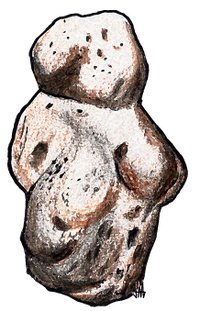 Venus of Berekhat Ram, dated between 800,000 and 233,000 B.C.
Venus of Berekhat Ram, dated between 800,000 and 233,000 B.C.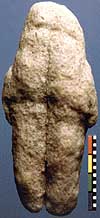
 Venus of Tan-Tan, dated between 500,000 and 300,000 B.C.The Age of the Goddess
Venus of Tan-Tan, dated between 500,000 and 300,000 B.C.The Age of the Goddess The written word has certainly been the most useful tool for gathering history about ancient religion. Oral tradition always changes with the teller and it takes only one link in the generational chain to break for the entire tradition to be lost to the void. With the revolution of writing came the ability for future generations to understand the world on a larger scale, and it is due to the lack of it that we only know about 5% of the human story (or 0.1% of the hominid story). But there is another accessory of mankind that has given us a glimpse into the dark age of human illiteracy: the idol. Throughout the final fifth of our lost tale of the homo sapien, stone statuettes of a large-breasted woman were carved into soft stones such as steatite, calcite, or limestone have been discovered throughout Europe and Asia. Although archaeologists have been extremely reluctant to provide any definitive explanation for their cultural significance, the most common sense answer is that they represent religious iconography. What makes this very remarkable is that that’s nearly all that is known to have been carved throughout Europe and Asia for about 15,000 years. With this kind of pedigree, the Venus figurines are doubtless the most far-reaching cultural practice unearthed by archaeology. What other cultural belief or practice can claim to have traveled so far or has been around for so long? What’s more, how did such a practice get to be so widespread in a time before cities or roads or a known written language?
The majority of these statuettes, carved in either stone or ivory, hold key recognizable features that prove cultural solidarity: a featureless golf-ball head, tiny bent arms covering immense sagging breasts, a swollen possibly-pregnant belly, gigantic hips and buttocks narrowing down to pin-size feet. The “Venus” figurines portray an unmistakably original, yet they have been found across France, Spain, Germany, Italy, Switzerland, Austria, Czechoslovakia, Turkey, Israel, the Middle East, Russia, and as far east as Mal’ta (a little north of China). The overwhelming predominance of feminine statuettes over masculine ones gives unmistakable evidence that the principal representation of God for the majority of
homo sapien history has been that of a woman.


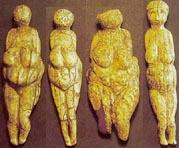



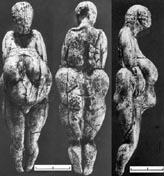
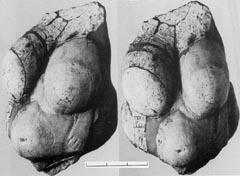










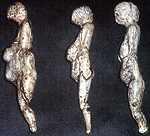










 Prehistoric “Venus” Figurines discovered throughout Europe and Asia show a remarkable resemblance to one another
Prehistoric “Venus” Figurines discovered throughout Europe and Asia show a remarkable resemblance to one another
Little can be proven regarding the beliefs of those who carved the Venus figurines those thousands of years ago, and despite many shared characteristics, there has been a great reluctance to identify her as the same earth goddess known throughout Paleolithic Europe from 7,000 to 1,700 B.C. But the significance of the lack of variety in these idols through such a large amount of time and space I believe suggests something that is unthinkable to historic sensibilities: prehistoric monotheism. This seems incredible because by the dawn of written word, the world was almost entirely polytheistic. The first archaeological evidence of monotheism being practiced is that of the cult of sun god Aten in Egypt in the 1300s B.C., started by the “heretic” pharaoh, Akhenaten, and it is not generally believed to have gone very far. Adam is usually dated to 4004 B.C., but it is Abraham, who is believed to have lived some time around 1600 B.C., who is usually given credit as being the first monotheist. Today about 53% of the world believes in one God due to a monotheistic revolution that spread throughout the western world starting with Judaism and Zoroastrianism some two millennia ago. Although Judaism now only makes up 0.2% of world religions today (and Zoroastrianism making up far less), the monotheistic revolution spread to both Christianity (33%) and Islam (20%), and now maintains a slight majority in world opinion. If these idols really are heirlooms from a long lost monotheistic age, then perhaps we can think of there having been a polytheistic revolution that took place some time before the first known language. This may have been linked to the establishment of cities, in which city councils began to take on a larger role in centralizing governments, which mirrored the concept of a “council of gods” that governed the world.
The predominance of feminine iconography must also prompt us to re-evaluate the way history looks at prehistoric man. How can we reconcile this predominantly feminine form of veneration with the common portrait of ancient life consisting of violent social groups ruled by instinctive alpha males who follow the animalistic urges of their Freudian
Id and horde the tribe’s women as concubines? Were women completely dominant over men in some long lost matriarchal age? Or was the figure not so much a glorification of an actual deity but more of an abstract symbol of life? The lack of information begs for speculative bridges to be constructed. Certainly the Venus figurines show a centralization of culture far surpassing the conceptualizations of ancient humans worshipping
ad hoc gods that differ from tribe to tribe.
Although no Venus figurine found has been dated after 12,000 B.C., I beleive that there is good evidence the goddess did not immediately die out with the advent of civilization. Excavations of the Neolithic settlement in Chatal Hyuk, Turkey, dated to around the 6700’s B.C., have turned up a far greater number of “earth mother” figurines over that of the male god, one of them being a large goddess sitting on a throne flanked by two lions. Hundreds of bear goddess figurines have been discovered around Celtic Gaul and Britain and dated to 5,000 B.C. The figurines portray a mother bear nursing her cubs, which has had a long association with feminine fertility. In fact, the term to “bear children” comes from this association with the bear, in that the Scottish word for child, “bairn,” is derived from the Anglo-Saxon word for bear, “beran.” Sumerian statues dated to around 2,000 B.C. portray the fertility goddess Inanna with features too similar to the Venuses to be coincidental: large breasts covered by small hands and a barbell shape very reminiscent of the prehistoric Venuses. Although the Sumerian statues have faces on them, the same bead-like circles of the Venuses can be found around their head and pubic area. There are also a lot of contradictions within Sumerian sources as to how Inanna fits into the Sumerian pantheon’s family tree, which suggests the deity was embedded into the mythology at different times by different people. Unlike most of the other gods, who are repeatedly referred to as bull gods, Inanna’s totem animal is that of the lion. However, the connection between the Paleolithic Venus figurines and the goddesses of "earth mothers" of Chatal Hyuk and the Sumerian societies have been greatly contested, most especially due to the absense of archaeological evidence in the intervening Mesolithic era between 11,500 and 7,500 B.C.
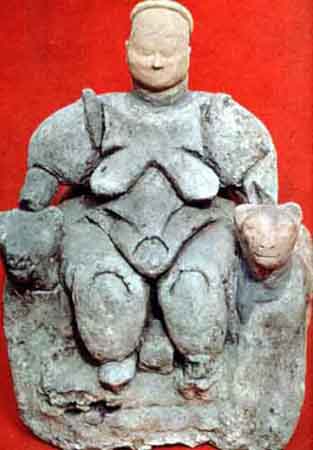 Goddess figurine from Chatal Hyuk with lions on each side of her
Goddess figurine from Chatal Hyuk with lions on each side of her
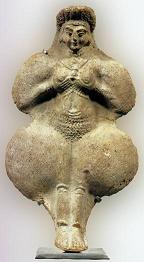 Inanna figurines shows wide hips and hands-on-breasts exhibited by Venus figurines
Inanna figurines shows wide hips and hands-on-breasts exhibited by Venus figurines As explained in the prior chapter, Inanna was part of the death and rebirth cycle along with her lover, Dumuzi, an earlier manifestation of Dionysus, who symbolized the cyclical change between the summer and winter season that lie behind the Easter and Christmas holidays. To the monotheistic Jews, Inanna was the abominable Ashtoreth, or “Lady of Shame.” The author of Revelation refers to her as the “whore of Babylon.” In the Akkadian language of the Epic of Gilgamesh, she is called Ishtar. She would later be known to the Syrians as Sybil, to the Assyrians as Mylitta, to the Canaanites as Astarte or Asherah, to the Egyptians as Hathor, to the Hittites as Shaushka or Ishtar, to the Greeks as Aphrodite, to the Romans as Venus, to the Norse as Freya or Ostara and to the Saxons as Eostre. It’s from this Anglo-Saxon name that we get the name of our own holiday marking the seasonal change of the Spring Equinox. The Easter bunny and the Easter egg are also both rooted in pagan fertility symbolism: the bunny because of its reputation for accelerate proliferation and the egg for it’s association with new birth.
Naming the ancient figurines after the Roman goddess of love was not a conscious attempt to link the ancient goddess to the Roman one though. The name stuck after it was first used by the Marquis Paul de Vibraye in 1864 under the name
Venus Impudique, or “Immodest Venus,” to describe a heavily damaged and particularly slimmer-looking goddess statue made of mammoth ivory. It was meant to be an ironic reference to the term
Venus Pudica, or “Modest Venus,” a term used to describe a classic pose in Western art in which a nude female keeps one hand covering her private parts. This was made to contrast the unashamed depiction of the feminine anatomy on the ancient figurines with that of the more modern “modest” portrayal in western art. The pose, however, that of hands holding or covering the breasts, is comparable. If it’s possible to trace the fertility goddess from prehistory to the Sumerians, Canaanites, Hittites, Greeks, and Romans, the name may have been more appropriate than the Marquis had imagined.
<t
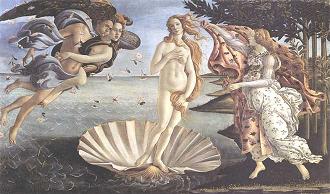 Modest Venus
Modest Venus Immodest Venus
Immodest Venus